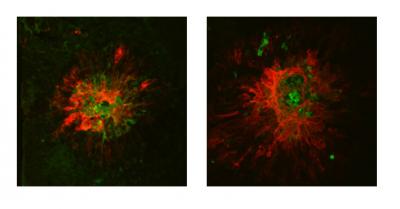
7-ketocholesterol accelerates fibrosis of choroidal neovascularization. Choroidal flat mounts labeled for endothelial cells by lectin (green) and mesenchymal cells by alpha smooth muscle actin (red). Left shows control; right shows 7-ketocholeserol induced transitioned cells.
The latest research from the laboratory of John A. Moran Eye Center physician-scientist Mary Elizabeth Hartnett, MD, reveals how an oxidized form of cholesterol can change choroidal endothelial cells into cells that become scars and may wreak havoc in the eyes of age-related macular degeneration (AMD) patients.
The oxysterol 7-ketocholesterol (7KC) builds up in the body as a person ages, and in diseases including cancer and heart disease. In the eye, 7KC accumulates in Bruch’s membrane with age and in AMD—a leading cause of blindness for people over 55.